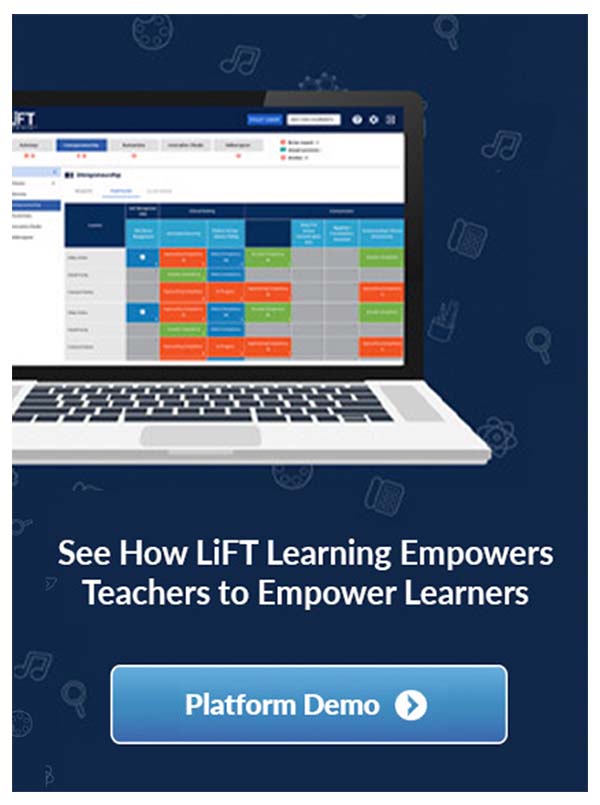Use stimulus funding to choose a learner-centered platform aligned with your vision
As part of the Coronavirus Aid, Relief, and Economic Security (CARES) Act, Congress has provided financial support for districts and schools with Elementary and Secondary School Emergency Relief (ESSER) Funds to address the ongoing impact of the COVID-19 pandemic. These funds offer schools and districts the flexibility to address their critical areas of need as they support their students, educators, and families.
If your ultimate goal is a vision modeled on the core beliefs of Project-Based Learning and Competency-Based Education, LiFT, a customizable project and portfolio assessment platform built on the principles of learner agency, real-world learning, and authentic assessment, may be the answer for you.
Bringing LiFT into your school or district meets the criteria for ESSER funding.
Districts have significant flexibility in how to use ESSER funding. Given the enormous influx of resources allocated to K-12, now is the time to drive important, sustainable change in your district.
WHAT CAN ESSER FUNDING SUPPORT?
ESSER Funds can support activities such as:
- Education Technology
- Addressing Learning Loss
- Long-term Closure Activities
- Mental Health Services
- Summer Learning
ESSER Funds can also support improvements or modifications that help prevent transmission of the COVID-19 virus:
- Improving Preparedness and Response
- Training to Minimize Virus Transmission
- Supplies to Sanitize and Clean & Improve Air Quality
- Facility Repairs/Improvement to Minimize Virus Transmission
- Coordination of Preparedness and Response
Consider how you will invest your ESSER funds with LiFT to provide support that will:
- Encourage students to pursue their own curiosity with co-created projects, combined with skills portfolios that capture evidence of learning across classes.
- Empower teachers with a customizable, learner-driven technology platform to teach and assess mastery of skills through interdisciplinary projects.
- Help administrators successfully implement their learner-centered vision.
To learn about the stimulus funding and how to use it to accelerate student learning, schedule a consultation with our Chief Learning Officer today.
As part of the Coronavirus Aid, Relief, and Economic Security Act (CARES Act), Congress has provided financial support for districts and schools through the Elementary and Secondary School Emergency Relief (ESSER) Funds to address the ongoing impact of the COVID-19 pandemic. These funds offer schools and districts the flexibility to address their critical areas of need as they support their students, educators, and families.
ESSER I Funds $13 Billion Schools must spend these funds by September 30, 2022.
ESSER II Funds $54 Billion Schools must spend these funds by September 30, 2023.
ESSER III Funds $122 Billion For public elementary, middle, and high schools.
$2.7 Billion For non-public schools
$1 Billion For Head Start
This past year has reinforced the nation’s belief that, even with limited resources, teachers are incredibly resilient and able to meet a broad array of challenges such as school closures, distance learning, and ensuring the safety of the students in their classroom. When provided with a platform that can help make connections between how students are learning with what students are learning, teachers’ effectiveness improves and their instructional practice continues to enrich classroom engagement.
As K-12 continues to move towards a generational change embracing education technology, sifting through the influx of solutions can be a monumental task. Decision-makers are compelled to use funding they have, including federal relief funding, to meet instructional needs now and into the future.
The federal government has made over $190 billion available in funding to help meet learning needs including, but not limited to, provisions for –
ADDRESSING learning loss
• addressing learning loss through evidence-based interventions that respond to students’ academic, social, and emotional needs
PURCHASING education technology
• purchasing educational technology (including hardware, software, and connectivity as well as assistive technology or adaptive equipment). Bringing LiFT into your school or district meets the criteria for ESSER funding.
RESOURCES for schools
• providing principals and school leaders with resources necessary to address individual school needs, homelessness, and foster care youth
ACTIVITIES for unique needs
• conducting activities to address the unique needs of students from low-income families, children with disabilities, English learners, racial and ethnic minorities, students experiencing homelessness, and foster care youth
PLANNING for closures
• planning for, coordinating, and implementing activities during long-term school closures including providing technology for online learning to all students
SUPPLEMENTAL Learning
• summer learning, and supplemental after-school programs
Decision-makers need to make choices soon for CARES Act funding, while selections for HR 133 and the American Rescue Plan could be made concurrently to save time and energy.
Each federal funding opportunity has separate dates when monies must be obligated, or released by (see chart below). While the dates for obligated funds vary per state, most require the Districts to report their needs by July 30, 2021. Check your state application forms or ask your district or state grant representative. For more information on how funds are allocated by state, click here.

